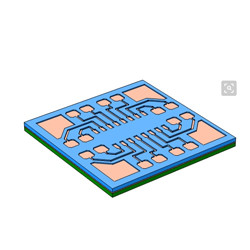With the development of PCB equipment to light, thin, short and high density, they put forward higher requirements for many PCB equipment and production process. Among them, the PCB circuit pattern spacing is getting smaller and smaller, and the hole copper thickness requirements are higher and higher, which poses a new challenge to the uniformity of pattern plating equipment. When the pattern electroplating line of Hebei Ruist company uses the whole board fine wire (small spacing is 3.5 mils) to treat the circuit board, the fine wire on the side of the circuit board is easy to get stuck, resulting in scrapping. In addition, it is found that the distribution of the conventional copper thickness on the board is not uniform, which makes the semi-finished chip unable to judge the copper hole and the copper thickness of the semi-finished product effectively. Therefore, it is decided to carry out special test analysis on the coating uniformity of the production line and improve the microstructure.
1. Improvement principle:
1) The plating window of the whole graphic plating line is 52 × 24 (Inch 2), and the depth direction is 24 inch;
2) Use Shengyi FR-4 plate, size: 24x24 inch, 2 pieces of this size plate and discharge in the electroplating bath for testing;
3) Test plate 0-1 inch from the surface of the solution, suspended in the middle of the solution, without splitter bar, 22 ASF, electroplating for 60 minutes;
4) The depth direction refers to the direction of the circuit board from the surface of the plating solution to the bottom of the solution, and the horizontal direction refers to the direction parallel to the cathode rod;
5) The measuring instrument is Fischer's inductive surface copper thickness tester, and the measurement error is less than 0.5um;
6) Two inches of copper thickness was measured from each of the two copper plating points during the test;
7) Since each test, there are 576 data on both sides of the 2 plates. Due to space limitation, this paper only shows the schematic diagram of each frontal measurement. Data from 7 tests, attached as attachments, with separate documentation.
2. Improvement objectives and methods:
1) Overall cov (percentage of standard deviation to overall average) < 11% (industry reference standard < = 8-12%);
2) The average thickness of copper plating in depth direction (very poor in depth direction) < 3um.
4, times of test:
Line 12 was selected for uniformity test. The overall cov was 20.8%. The horizontal inhomogeneity is mainly on both sides of the plate. It can be avoided and improved by adding a shunt rod on both sides of the frame and adjusting the anode spacing.
In addition, from the distribution map of average copper thickness in depth direction (as shown in Figure 1), the following problems can be seen:
As shown in Figure 1 above:
First, the average copper thickness distribution along the depth direction is measured
Fig. 1 Distribution of average copper thickness in test depth direction
(1) In the 1-3 inch area of the liquid surface, the copper thickness is 4.1 um higher than the average copper plating thickness of the whole plate;
(2) The thickness of copper is 4.8um thinner than the average value of the whole plate in the 20-24 inch area of the liquid surface;
The average value of deep copper plating is 8.9 μ M.

 中文(簡體)
中文(簡體)







